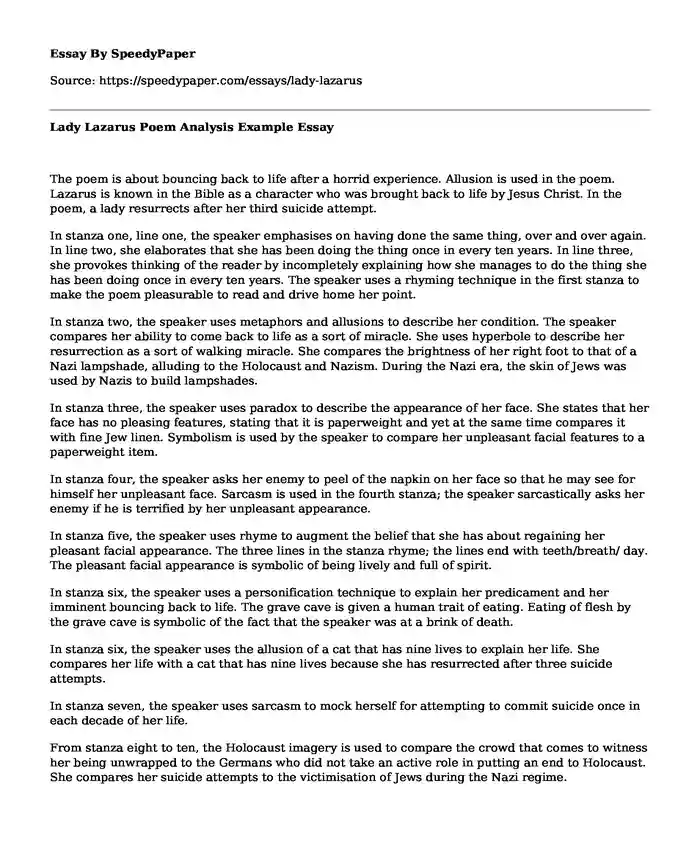
| Type of paper: | Essay |
| Categories: | Poem Sylvia Plath |
| Pages: | 3 |
| Wordcount: | 717 words |
The poem is about bouncing back to life after a horrid experience. Allusion is used in the poem. Lazarus is known in the Bible as a character who was brought back to life by Jesus Christ. In the poem, a lady resurrects after her third suicide attempt.
In stanza one, line one, the speaker emphasises on having done the same thing, over and over again. In line two, she elaborates that she has been doing the thing once in every ten years. In line three, she provokes thinking of the reader by incompletely explaining how she manages to do the thing she has been doing once in every ten years. The speaker uses a rhyming technique in the first stanza to make the poem pleasurable to read and drive home her point.
In stanza two, the speaker uses metaphors and allusions to describe her condition. The speaker compares her ability to come back to life as a sort of miracle. She uses hyperbole to describe her resurrection as a sort of walking miracle. She compares the brightness of her right foot to that of a Nazi lampshade, alluding to the Holocaust and Nazism. During the Nazi era, the skin of Jews was used by Nazis to build lampshades.
In stanza three, the speaker uses paradox to describe the appearance of her face. She states that her face has no pleasing features, stating that it is paperweight and yet at the same time compares it with fine Jew linen. Symbolism is used by the speaker to compare her unpleasant facial features to a paperweight item.
In stanza four, the speaker asks her enemy to peel of the napkin on her face so that he may see for himself her unpleasant face. Sarcasm is used in the fourth stanza; the speaker sarcastically asks her enemy if he is terrified by her unpleasant appearance.
In stanza five, the speaker uses rhyme to augment the belief that she has about regaining her pleasant facial appearance. The three lines in the stanza rhyme; the lines end with teeth/breath/ day. The pleasant facial appearance is symbolic of being lively and full of spirit.
In stanza six, the speaker uses a personification technique to explain her predicament and her imminent bouncing back to life. The grave cave is given a human trait of eating. Eating of flesh by the grave cave is symbolic of the fact that the speaker was at a brink of death.
In stanza six, the speaker uses the allusion of a cat that has nine lives to explain her life. She compares her life with a cat that has nine lives because she has resurrected after three suicide attempts.
In stanza seven, the speaker uses sarcasm to mock herself for attempting to commit suicide once in each decade of her life.
From stanza eight to ten, the Holocaust imagery is used to compare the crowd that comes to witness her being unwrapped to the Germans who did not take an active role in putting an end to Holocaust. She compares her suicide attempts to the victimisation of Jews during the Nazi regime.
In stanza eleven, the speaker states that the first time she committed suicide, it was accidental. In stanza twelve, the speaker states that the second time she committed suicide, it was deliberate.
In stanza fifteen, an irony is used. The speaker states that she has perfected the art of dying when she has attempted suicide three times to no avail.
From stanza twenty to twenty-two, the speaker uses self- parody by comparing her scars to those of Jesus Christ after His crucifixion. The speaker states that people should be charged to view her scars, hear her heartbeat, words or touch her blood, hair or clothes. In stanza eighteen, the speaker reveals that her enemy is a male German who is in authority.
In stanza twenty-three, the speaker uses diction by comparing herself to an opus and a gold baby. An opus is a work of art; she compares her behaviour to that of a work of art.
In the last stanza, stanza twenty-eight; the speaker reveals that the poem also has a goal of revenging on the male ego for a supposedly patriarchal society.
Work Cited
Plath, Sylvia. Ariel. New York: Harper & Row, 1966. Print.
Cite this page
Lady Lazarus Poem Analysis Example. (2019, Nov 07). Retrieved from https://speedypaper.net/essays/lady-lazarus
Request Removal
If you are the original author of this essay and no longer wish to have it published on the SpeedyPaper website, please click below to request its removal:
- Absolutism Essay Sample
- Eating Disorder Essay Sample: The Thin Film Analysis
- Free Essay on the Use of Performance Enhancing Drugs in Sports
- Free Essay on Two General Ways that Psychologist Link Personality and Criminal Behavior
- Business Essay Example: The Rise and Fall of Starbucks
- Research Paper on Data Visualization Tools and Programming for Data Analytics
- Paper Example on Description of The Chosen Injury Prevention Intervention
Popular categories




